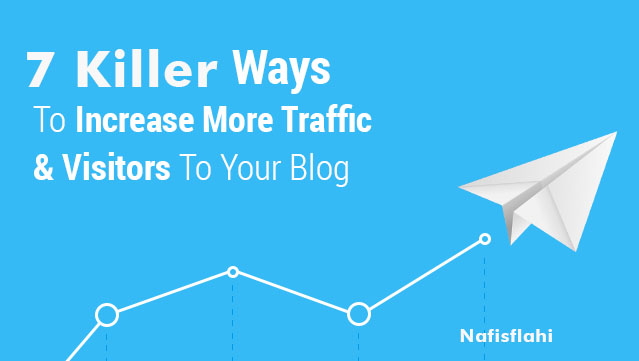Want to learn How To Get Traffic To Your Website, We are going to discuss 6 different ways to drive traffic to your website.
All of us when creating something, thinks about the people who will be interested in our hard work, be it connected to the internet, or not. Without the promising audience any work is ineffective and meaningless. So we should do our best to deserve the attention of our audience.
We can simply ask any marketer what is the most valuable thing in their business? I’m pretty sure their answer would be “more customers, and more traffic to your websites”.
You also share my opinion, aren’t you? So as getting more attention is a top priority for almost all online marketers, bloggers or website runners, through this post I’ve decided to speak about the ways, which will help you to easily gain more and more attention and traffic to your website.
Also Read : 6 Tips to Increase Page views Using Images on your blog
How To Get Traffic To Your Website?
#Write Better Content
A great content marketing strategy with catchy headlines won’t matter if you don’t have compelling content. Any readers who come to your site will just bounce out immediately – and that will make for an ugly traffic report.
So, how do you write more compelling content?
You can start by infusing these hacks into your writing…
Hack #1: Hook readers in from the beginning. People have low attention spans. If you don’t have a compelling “hook” at the beginning of your blogs, people will click off in seconds. You can hook them in by teasing the benefits of the article (see the intro to this article for example!), telling a story, or stating a common problem that your audience faces.
Hack #2: Use shorter paragraphs. Avoid long paragraphs and huge blocks of text. The more scannable your content, the better. So, try to keep paragraphs under 5-6 lines (ideally 2-3).
Hack #3: Read your writing aloud when editing. What looks good on paper doesn’t always sound good. So, by reading your content aloud, you can discover clunky phrases – and any errors will jump out to you.
Hack #4: Tell more stories. Stories connect with us emotionally and drive us to take action. Add stories into your content to prove arguments, hook readers in, explain a problem, and for whatever else you can think of. Stories are gold.
Also Read : How To Improve Your Page Rank on Google
#Write Enticing Headlines
Titles play an essential role for attracting attention. We all should bear in mind that even if your blog is the most interesting one, it will not have a notable number of readers without killing headlines.
As a fact, it is proven that the content’s headlines play more important role that the article itself. Present-day content headlines are more tricky. Apart from being creative and tricky, they contain SEO keywords as well.
It would be better if you include in your titles numbers. As colors draw our attention, numbers coupled with a text also attract us. You can also ask a question through the headline, they make titles stand out. Or you can make a list of various headlines and choose the most attractive one, as do many others.?
Now let me show you a list of words which will help you to make your headlines your desired one:
- Tricks
- Ways
- Reasons
- Secrets
- Ideas
- Methods
You can continue the list adding your versions. Besides of all this you should show the value of content through the headlines, you should try to convince your users that your product is useful, with needed information.
#Incorporate keywords.
Speaking of SEO, keywords are at the heart of SEO. One of the easiest ways to generate more traffic to your website is to ensure that every page on your site has a keyword strategy. So for each blog post you write, choose one key phrase that you believe readers would use to find that post. Next, incorporate that phrase into the title of the post, the headline on the page, within the content on the page at least two times, in a featured image on the page and also as part of the page link. Keyword concentration helps Google understand what that page is about, which can ultimately lead to more traffic from the search engines.
Also Read : 8 Tips on how To Keep Visitors Longer on Your blog
#Cross-promote to your mailing list.
Instead of writing all new content for your electronic newsletter, share the first paragraph from several recent blog posts and include a link to continue reading on the site. Not everyone is taking the time to read your blog each week, so this will help get your subscribers invested in your blog.
In addition to the tips above, the following smart strategies will also help increase readership:
16. Make your content easy to read by using plenty of subheads, bullets and numbered lists.
17. Promote your blog in your email signature and your bio in any online profiles.
18. Make it easy for blog visitors to subscribe to your RSS feed.
19. Invite readers to leave a comment, then respond and let them know you’re engaged.
20. Finally, have fun with your blog. If it feels like drudgery, your readers will notice. But if you enjoy producing the content, that will come across and have a tremendous impact on your success.
#Start Guest Blogging
Guest-blog marketing really works. Write an informative guest-blog and share it among reputable and trustworthy sites, it will undoubtedly increase the number of your page-guests.
For example you can write about your product, your service, or give useful advices through your blog. Be sure it is really productive way if you want to bring more attention to your product. Or you can encourage other bloggers to post their guest-blogs on your site, it’s also a good solution.
Undoubtedly they will share their blogs in various social networks, bringing to your web-page new visitors. But before others post their articles on your web-page, you need to be sure that the blogs are unique and with a high quality.
#Internal Linking (important!)
Internal linking refers to adding links from one page on your website to another page on your website. This can mean you’re adding links from one blog post to older posts, or from certain pages to other pages.
Most websites don’t use internal linking nearly enough. Sure, you shouldn’t overdo it with 40-50 internal links in each blog post – but there is a happy medium.
Why bother with internal linking? These types of links are useful because they help your readers navigate your website, help improve the search rank of the pages you link to, and help define the architecture and hierarchy of your website.
Here’s how you can get the most out of internal linking:
- Create more content. The more quality content you create, the more quality content you can link to. It’s really that simple.
- Use the right anchor text. Using our previous example: if you wanted to internally link to the “how to quit your job” blog post, you can write a sentence in another blog, like “Once you know [how to quit your job], you can start a business and travel the world.” In this case, the reader has a compelling case for clicking on the link because of both the anchor text (“how to quit your job”) and the context of the sentence. There is a clear benefit from clicking the link.
- Link to relevant content. Don’t link for the sake of linking – always link to content that will add to your readers’ experience.
- Don’t overdo it. Anywhere from 5-10 internal links can be used in a 1,000-word blog post. Any more than that and you’ll overdo it.
If you feel this post is helped you pleas do share with your friends and family on Facebook,Twitter,etc




